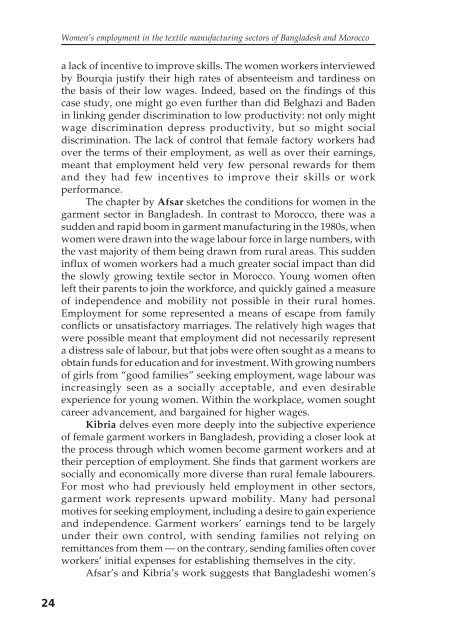Women's Employment - United Nations Research Institute for Social ...
Women's Employment - United Nations Research Institute for Social ...
Women's Employment - United Nations Research Institute for Social ...
Create successful ePaper yourself
Turn your PDF publications into a flip-book with our unique Google optimized e-Paper software.
Women’s employment in the textile manufacturing sectors of Bangladesh and Morocco<br />
a lack of incentive to improve skills. The women workers interviewed<br />
by Bourqia justify their high rates of absenteeism and tardiness on<br />
the basis of their low wages. Indeed, based on the findings of this<br />
case study, one might go even further than did Belghazi and Baden<br />
in linking gender discrimination to low productivity: not only might<br />
wage discrimination depress productivity, but so might social<br />
discrimination. The lack of control that female factory workers had<br />
over the terms of their employment, as well as over their earnings,<br />
meant that employment held very few personal rewards <strong>for</strong> them<br />
and they had few incentives to improve their skills or work<br />
per<strong>for</strong>mance.<br />
The chapter by Afsar sketches the conditions <strong>for</strong> women in the<br />
garment sector in Bangladesh. In contrast to Morocco, there was a<br />
sudden and rapid boom in garment manufacturing in the 1980s, when<br />
women were drawn into the wage labour <strong>for</strong>ce in large numbers, with<br />
the vast majority of them being drawn from rural areas. This sudden<br />
influx of women workers had a much greater social impact than did<br />
the slowly growing textile sector in Morocco. Young women often<br />
left their parents to join the work<strong>for</strong>ce, and quickly gained a measure<br />
of independence and mobility not possible in their rural homes.<br />
<strong>Employment</strong> <strong>for</strong> some represented a means of escape from family<br />
conflicts or unsatisfactory marriages. The relatively high wages that<br />
were possible meant that employment did not necessarily represent<br />
a distress sale of labour, but that jobs were often sought as a means to<br />
obtain funds <strong>for</strong> education and <strong>for</strong> investment. With growing numbers<br />
of girls from “good families” seeking employment, wage labour was<br />
increasingly seen as a socially acceptable, and even desirable<br />
experience <strong>for</strong> young women. Within the workplace, women sought<br />
career advancement, and bargained <strong>for</strong> higher wages.<br />
Kibria delves even more deeply into the subjective experience<br />
of female garment workers in Bangladesh, providing a closer look at<br />
the process through which women become garment workers and at<br />
their perception of employment. She finds that garment workers are<br />
socially and economically more diverse than rural female labourers.<br />
For most who had previously held employment in other sectors,<br />
garment work represents upward mobility. Many had personal<br />
motives <strong>for</strong> seeking employment, including a desire to gain experience<br />
and independence. Garment workers’ earnings tend to be largely<br />
under their own control, with sending families not relying on<br />
remittances from them — on the contrary, sending families often cover<br />
workers’ initial expenses <strong>for</strong> establishing themselves in the city.<br />
Afsar’s and Kibria’s work suggests that Bangladeshi women’s<br />
24
















